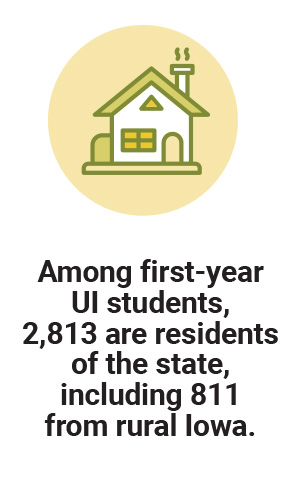Investing in the Hawkeye State
 PHOTO: JUSTIN TORNER/UI OFFICE OF STRATEGIC COMMUNICATION
UI grad Mylo Wells returned to his Iowa hometown to open a pharmacy.
PHOTO: JUSTIN TORNER/UI OFFICE OF STRATEGIC COMMUNICATION
UI grad Mylo Wells returned to his Iowa hometown to open a pharmacy.
Educating for Iowa’s Future
Mylo Wells (18PharmD) graduated from the University of Iowa College of Pharmacy in 2018 and opened pharmacies in his hometown of Bloomfield, Iowa, and nearby Keosauqua. After benefiting from mentors throughout his training, Wells now serves as a preceptor for the UI College of Pharmacy, hosting rotations for student pharmacists at Wells Hometown Drug.
“We’re providing a really high level of pharmacy care, and I feel good about doing that because I grew up around here, and I know that it’s affecting people who helped me when I was growing up,” Wells says. “That means a lot to me.”
Wells is among thousands of UI-educated medical professionals who live and work across Iowa, serving alongside UI Health Care in bridging the gap in health care access for a state where a third of the population is rural.
For generations, the UI has attracted students from all 99 Iowa counties and around the globe to participate in its core missions of education, research, and service. As a recent study of the university’s economic value concluded, “The greatest economic impact of the UI stems from the added human capital—the knowledge, creativity, imagination, and entrepreneurship—found in its alumni.”
Whether they stay in Iowa like Wells or go farther afield, these alumni join the university in providing valuable services to their communities and making a substantial economic impact on the state, as can be seen through this data.






Small Towns, Big Impact
From a young age, Ryan Daisy (22JD) witnessed the ways attorneys serve communities. His mother works as a legal assistant at a Carroll, Iowa, law firm, and he noticed that attorneys were often active citizens and trusted mentors beyond their legal work. That background also gave Daisy an appreciation for the challenges many Iowa communities face when they can’t access a legal advisor. A 2020 American Bar Association study reported that Iowa’s 10 most populated counties have 73% of the state’s lawyers.
Today, Daisy works to address the state’s attorney shortage in underserved areas as chair of the Rural Practice Committee Program, which finds career opportunities for young attorneys across Iowa. Daisy founded the Rural Interest Group in 2020 at the UI College of Law. The group assembles students interested in rural practice and connects the college to the Iowa State Bar Association and practitioners in small communities.
Students receive advice and job opportunities from rural attorneys, some of whom speak on campus about their experiences. “Many shared a similar mantra: ‘You’re a big fish in a small pond,’” says Daisy, an associate attorney for Willson & Pechacek, a Council Bluffs-based law firm, with offices in six smaller Iowa towns. “You can be a leader, well involved, and have all these opportunities to make a big impact.”

STARS College Network Supports Rural Students
Arriving at the University of Iowa from Sioux Center, a northwest Iowa town with a population of 8,000, Mayra Gomez was overwhelmed with all the opportunities to get involved and meet new people. After spending her high school years with the same students in every class, it was intimidating to enter classrooms where she didn’t know everyone.
“The transition was not easy at first,” says Gomez, a sophomore political science major with a news and media literacy minor. “I was initially shy going into every class and thought to myself, ‘How will I ever make friends?’ But once you arrive as a student, you realize everyone is in the same boat as you.”
As a student ambassador for the STARS (Small-Town and Rural Students) College Network, Gomez now helps other students from similar backgrounds find support to enroll in and graduate from college. STARS is in its second year partnering with Iowa and other colleges nationwide to reach rural students with resources such as financial aid tutorials, college application workshops, and question-and-answer sessions.
Research shows that rural students are half as likely to graduate from a top university as their peers in metro areas. STARS aims to change this tide and encourage an ongoing cycle of support and success for rural students.
“We’re proud to have been a founding member of this important effort to expand educational access for students in Iowa and nationwide,” says Brent Gage, UI associate vice president for enrollment management and strategy. “The growth of this coalition strengthens our ability to support students from all economic and geographic backgrounds.”



